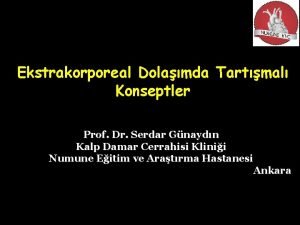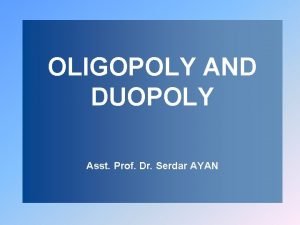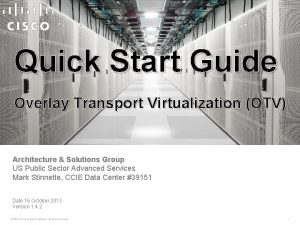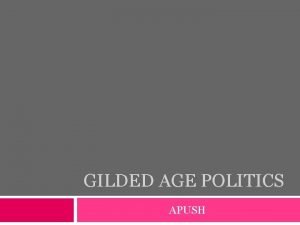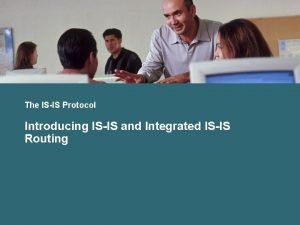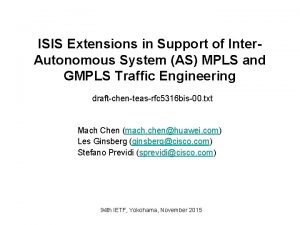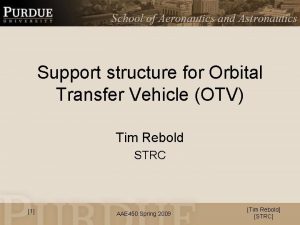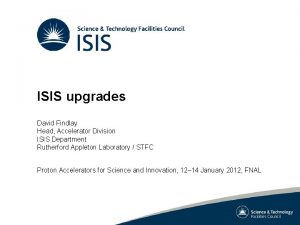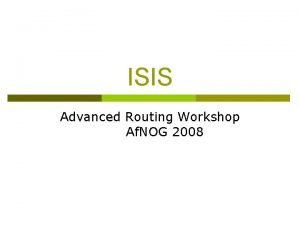ISIS Extensions to support OTV Hasmit Grover Ayan














- Slides: 14

IS-IS Extensions to support OTV Hasmit Grover Ayan Banerjee Dhananjaya Rao

Overlay Transport Virtualization • OTV is a L 2/L 3 Virtualization Solution for Enterprise environments • Transparent L 2 extension for enterprise sites • L 2 and/or L 3 connectivity for site devices • Multi-site multi-point connectivity • Extremely simple provisioning and management

Overview • MAC Routing – Uses control plane advertisements instead of data plane learning – Remote site MACs learnt via control plane – No unknown unicast flooding • Inter-site data sent as IP packets – Routed to destination Edge Devices – No pre-built tunnels • STP terminated at each site

Overview • OTV forms an overlay network – Auto-discovery – Unicast/multicast route exchange • OTV functionality only in edge devices – Transparent to core and site devices • Core transport agnostic

Overlay Network VPN o. UMRP VPN A Site 1 VPN A Site 2 Edge Devices Overlay B X Core Network VPN B Site 1 VPN B Site 2 X p. UMRP p. STP/Snoop VPN A Site 3 Legend: red: L 2 green: L 3 UMRP: Unicast/Multicast Routing Protocol In core: - No flooding of site L 2 data - No coordinated site state for L 2 or L 3 - No coordination between core and site X VPN B Site 3 On the overlay: - o. UMRP carries unicast/multicast MAC addresses - Use IP multicast in core for control and data to all sites of a given VPN - Packets sent on overlay are encapsulated in IP c. UMRP c. STP/Snoop(1) c. UMRP c. STP/Snoop(2) c. UMRP c. STP/Snoop(3)

Data Forwarding • Unicast packets encapsulated and routed to overlay “next-hop” – Load-balancing and ECMP across core and overlay • Multicast uses Delivery Groups across core – Data sent within (DS, DG) by source Edge Devices – Optimal multicast replication by core network • Broadcast data sent as IP multicast – All Edge Devices join this core multicast tree

Multi-homing • OTV provides loop-free multi-homing • Authoritative Edge Device (AED) per site – Edge Devices in the site elect AED • Only AEDs forward traffic on overlay – Avoids loops and duplicates • Traffic load-balanced among Edge Devices – Per-VLAN AED

Overlay Routing Protocol • IS-IS used as o. UMRP – Edge Devices run IS-IS at L 2 on overlay – Provides auto-discovery and authentication – Carries both unicast and multicast routes • Easily extensible • Leverage existing Layer-2 IS-IS extensions • Operational benefits of using one protocol

IS-IS extensions • Protocol packet extensions – TLVs, sub-TLVs, PDUs • No major changes to protocol behavior • IS-IS on overlay uses LAN procedures

IIH extensions • Multi-Topology aware Port Capability defined in RFC 6165 • Define new sub-TLVs – Site Capability – Site Group IPv 4 – Site Group IPv 6 – Adjacency Server IPv 4 – Adjacency Server IPv 6

LSP Extensions • Group Address TLV defined in RFC 6326 • Define new sub-TLVs – Group IPv 4 Address – Group IPv 6 Address • Group Membership Active Source TLV (new) • Define Sub-TLVs – Group MAC Source – Group IPv 4 Source – Group IPv 6 Source

MGroup PDU • Multicast Group PDU – Carries multicast specific information – MGroup CSNP – MGroup PSNP

I-Ds • Overlay Transport Virtualization http: //www. ietf. org/id/draft-hasmit-otv-03 • IS-IS Extensions to support OTV http: //tools. ietf. org/html/draft-drao-isis-otv-00

Next Step • Authors would like to solicit comments and feedback



